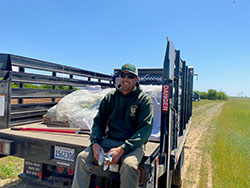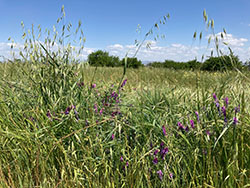A three-acre field is planted with a combination of sunflower and safflower seeds to provide food for mourning doves – and a place for dove hunters to hunt come Sept. 1.

Oroville Wildlife Area Manager AJ Dill sits on the back of a flatbed truck stacked with sacks of safflower and sunflower seed and fertilizer for the spring planting season.

Fish and Wildlife Technician Brian Young holds handfuls of safflower and sunflower seeds prior to planting.

Upland habitat planted in the fall is lush and colorful in the spring providing important nesting habitat for wild mallards and Canada geese near the shores of the Thermalito Afterbay.
It only took Brian Young about two laps around the freshly plowed, three-acre field before the red-winged blackbirds started showing up.
A fish and wildlife technician at the Oroville Wildlife Area in Butte County, Young was piloting a John Deere 5075M utility tractor along the shores of the Thermalito Afterbay in mid-April, scattering a mix of sunflower and safflower seeds behind him. The red-winged blackbirds were taking full advantage of the easy meal.
Once seeded, Young would retrace his route, distribute fertilizer and hope for the best. A quarter-mile away along a gently sloping hillside another John Deere tractor was at work covering up with soil another plowed, seeded and fertilized field.
Spring is planting season at the 12,000-acre Oroville Wildlife Area and at dozens of other California Department of Fish and Wildlife (CDFW) properties up and down the state as crop fields are prepared for mourning doves – and the dove hunting season that begins in September. And while planted to attract doves and provide public land dove hunting opportunities, the crop fields also will provide food and habitat for all manner of wildlife, including those red-winged blackbirds.
“Native songbirds, tricolored blackbirds, wild turkeys – you name it. Just about anything that flies – with the exception of our raptors – will be out here feeding in these fields throughout the fall,” explained AJ Dill, the Oroville Wildlife Area manager since 2013.
Safflower and sunflower are mourning dove favorites. A couple weeks before the Sept. 1 dove season opener, the Oroville Wildlife Area’s tractors will be back to knock down the safflower and sunflower stalks and scatter the seeds to the ground where doves can access them more easily.
Mourning doves are especially attracted to harvested agricultural fields and the food plots at Oroville and other CDFW properties can provide fast action for public land dove hunters on opening day and places to hunt throughout the season. At Oroville, however, hunters have to do their homework. Unlike some other wildlife areas, Oroville does not provide hunting maps or directions to its dove fields. Hunters have to scout and find them on their own. A Type C wildlife area, Oroville is open daily to dove hunting during California’s two dove seasons. No special permits, reservations or fees are required provided hunters are otherwise properly licensed.
This spring, the Oroville Wildlife Area will plant about 60 acres of safflower and sunflower among 16 different fields varying in size throughout the wildlife area. The dove fields are spaced out to spread out the hunters, prevent overcrowding and foster safer hunting conditions.
How productive the fields ultimately become will depend on many factors – but none more so than weather.
“Everything we do out here is dryland farming. We don’t irrigate. So we really need a shot of water – just a little bit of rain – to get things going,” Dill said.
A significant portion of the Oroville Wildlife Area’s upland habitat work also takes place in the fall when 80 acres of nesting cover are planted annually – typically some combination of vetch, barley, peas, wheat, oats, clover and grasses – along the shores of the Thermalito Afterbay to benefit nesting ducks and geese in the spring. The wildlife area maintains about 240 managed acres of upland nesting habitat in total, the dense cover providing nesting hens, their eggs and newborns safety and protection from predators.
As with the planted dove fields, the lush, colorful, nesting habitat provides secondary benefits to other grasslands-dependent species, particularly pollinators such as bumblebees, honeybees and butterflies. The loss of grassland and upland habitat throughout California has contributed to the decline of wild mallards, wild pheasants, pollinators and other species and adds a sense of urgency and heightened importance to the upland habitat work at the Oroville Wildlife Area and other CDFW properties throughout the year.
###
CDFW Photos